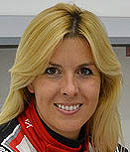 Mat Coch writes:
Mat Coch writes:
While motor sport looks as though it could swallow the Earth whole, as a community, it is incredibly small. As drivers and mechanics work their way from the junior formulae to the pinnacle everyone ends up knowing everyone; two wheels, four, it doesn't matter. Motor sport is one big family, awkward uncle and all.
Yesterday Maria De Villota reminded us all of that one, inescapable fact.
Racing drivers, although glamorised on television and through the media, are human. They possess the sort of talent behind the wheel of a racing car the rest of us can only fantasise about. We're the world's greatest barbeque cook but they are the world's greatest drivers. Every time they are strapped into their cars they risk their lives for our enjoyment, and garner our appreciation and admiration because of it.
They work with the world's greatest engineers and the world's greatest mechanics, all of whom rose to the upper echelons of motor sport from the junior categories. Motor sport is basically a Ponzi scheme.
Just a handful of weeks ago the sport rallied around Williams. A garage fire threatened to engulf not just the team's assets but the entire pit complex and those within it. Colours were cast aside and the sport, as one, averted a disaster of epic proportions.
Then, as now, the sport reached the headlines for voyeuristic reasons.
Few outside the inner sanctum of motor sport know de Villota and yet suddenly she is a household name. She is more famous than Narain Karthikeyan, and she's never taken part in an official Formula One session.
If Twitter can be used as a barometer of public opinion, and generally it can, reaction to the events of Tuesday morning were both immediate and heartfelt. World champions Fernando Alonso and Jenson Button expressed their concern, though none summed it up as well as fellow female racer Susie Wolff. "Please, please, please let Maria be okay," she Tweeted in desperation, her soulful pleas laid bare to the world.
Twitter has allowed the outside world in to that haloed inner sanctum of motor sport. We can read what those who matter are thinking; sometimes amusing, often dull it is an insight in to the sport's biggest personalities the likes of which has been reserved for those among that exclusive sanctum.
On her Tiwtter account de Villota was bubbling with enthusiasm ahead of her first Marussia test. While it was cut short the outpouring of support demonstrates the power of social media and its ability to convey public opinion in an open and immediate forum. It is better than any finger in any wind.
The team too deserves credit, especially its Public Relations department headed by Tracey Novak. Having lost a friend and stood on Tracey's side of the fence barely eighteen months ago I can empathise with the thankless task with which she has been presented. Answering and deflecting media attention when a colleague's life is apparently in the balance is the single most difficult task any media or public relations person faces.
Announcements from the team have been succinct, if a little clinical, portraying the important information with a sense of gravity yet without room for speculation. The sterile messaged calmed the media which in turn soothed the social media avalanche.
Without the use of Twitter and other social networking news would have been far slower in spreading, allowing more time for speculation and ever more difficult questions for the Marussia PR team. For all its flaw's Twitter has aided the positives that have emerged from De Villot'a story, and while it has also attracted unwanted and upsetting photos of the event it has more than made up for its shortcomings in other ways.
In this instance Twitter proved that, in a moment of crisis, we will cast aside our differences and rally around the things that really matter.

 Mat Coch writes:
Mat Coch writes:



















sign in